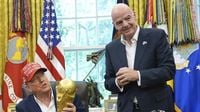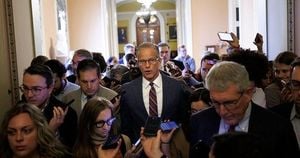On October 18, 2025, streets across the United States pulsed with the energy of tens of thousands as the "No Kings" protests swept through cities both large and small, voicing deep opposition to President Donald Trump’s administration and its recent policies. From New York’s Times Square to the heart of Washington, D.C., and stretching as far as Los Angeles and Miami, Americans gathered in a remarkable show of civic engagement—one that organizers say is a direct response to what they view as a dangerous drift toward authoritarianism under Trump’s leadership.
According to BBC, the rally in Times Square alone drew thousands shortly after it began on Saturday morning. The New York Police Department estimated that more than 100,000 people peacefully protested across all five boroughs, with no protest-related arrests made. Subway entrances were jammed, streets were packed, and the air was filled with the sounds of chants—"this is what democracy looks like"—and the clatter of cowbells and noisemakers. Protesters held signs with slogans such as “Democracy not Monarchy” and “The Constitution is not optional.”
Non-violence was a core principle of the "No Kings" events, as emphasized by organizers on their website and echoed by participants on the ground. “It gives me hope to be out here with many, many other people,” said Beth Zasloff, a freelance writer and editor, who joined the New York protest out of concern over what she described as a “move toward fascism and an authoritarian government.”
Saturday’s demonstrations represented the third mass mobilization since Trump’s return to the White House in January 2025. Organizers say this protest built on previous actions in April and June, which had 1,300 and 2,100 registered locations respectively. This time, more than 2,600 rallies were planned nationwide, coordinated by hundreds of coalition partners, according to CBC.
Top Democratic figures were visible and vocal in the protests. Senate Minority Leader Chuck Schumer joined marchers in New York, holding a sign that read “fix the health care crisis.” On social media, he declared, “We have no dictators in America. And we won’t allow Trump to keep eroding our democracy.” Vermont Senator Bernie Sanders delivered a keynote speech in Washington, D.C., telling the crowd, “We’re not here because we hate America, we’re here because we love America.” Sanders later posted, “It’s a love America rally. It’s a rally of millions of people all over this country who believe in our Constitution, who believe in American freedom and ... are not going to let you and Donald Trump turn this country into an authoritarian society.”
But the protests were not without controversy. Trump allies and Republican leaders accused participants of being linked to the far-left Antifa movement, labeling the rallies as “hate America” events. House Speaker Mike Johnson, for example, challenged the legitimacy of the protests, stating, “I encourage you to watch—we call it the Hate America rally—that will happen Saturday,” and listing groups such as “Antifa types” and “Marxists in full display.” Many protesters were angered by these characterizations. In Bethesda, Maryland, one demonstrator held a sign reading, “Nothing is more patriotic than protesting.” Brian Reymann, who carried an American flag in D.C., called the terrorist accusations “pathetic.”
Republican governors in several states took significant precautions. Texas Governor Greg Abbott activated the state’s National Guard on October 16, citing concerns over a “planned antifa-linked demonstration” in Austin. Virginia’s Governor Glenn Youngkin also ordered the National Guard to be on standby, though local reports said troops were not present during the protests. In D.C., where the National Guard has been deployed since August at Trump’s request, no troops were visible during the protest, but local police were on hand. Despite these preparations, the events remained peaceful, with no major incidents reported.
President Trump, meanwhile, was away from Washington at his Mar-a-Lago estate in Florida, preparing for a $1 million-per-plate MAGA Inc. super PAC fundraiser. In a Fox News interview aired on October 18, Trump addressed the issue of being referred to as a king, stating, “A king! This is not an act. You know—they’re referring to me as a king. I’m not a king.” He dismissed claims of authoritarianism as “hysterical,” maintaining that his actions were necessary to “rebuild a country in crisis.”
Underlying the protests is a broader political crisis: the federal government shutdown, now in its 18th day. Republicans have blamed Democrats for the closure, claiming that party leaders are beholden to the far-left and are using the shutdown as leverage. Democrats, for their part, have refused to vote on legislation to reopen the government without securing funding for health care, arguing that the closure is a necessary stand to restore the presidency to its place as a co-equal branch of government. “What we are seeing from the Democrats is some spine,” said Ezra Levin, co-founder of the progressive group Indivisible. “The worst thing the Democrats could do right now is surrender.”
Many protesters expressed frustration with what they see as a clampdown on free speech and a rollback of civil liberties. Massimo Mascoli, a retired engineer from New Jersey who grew up in Italy, said he was especially concerned about the administration’s immigration crackdown and healthcare cuts. “We cannot count on the Supreme Court, we cannot count on the government, we cannot count on the Congress. We have all the legislative, the executive and judiciary that are all against the American people right now. So we are fighting,” he told BBC.
The “No Kings” movement found echoes far beyond U.S. borders. Solidarity rallies took place in European cities such as Berlin, Madrid, Rome, and London, as well as in Toronto and Montreal. In downtown Montreal, Judith Henkewick, a dual citizen from Boston, said, “We’re here to support Canadian sovereignty and also definitely to support all Americans interested in keeping their democracy. There’s a problem in the south that has to be dealt with.”
Public opinion remains deeply divided. A recent Reuters/Ipsos poll found Trump’s approval rating at 40%, with 58% disapproving—a figure that has slipped since his return to office in January. Such polarization is not new in American politics, but the scale and tone of Saturday’s protests suggest that the struggle over the country’s direction is far from settled.
As the sun set on October 18, the message from city squares and streets across America was clear: for many, the fight for democracy and constitutional norms is as urgent as ever, and the debate over the nation’s future is playing out not just in the halls of power, but in the public square.




